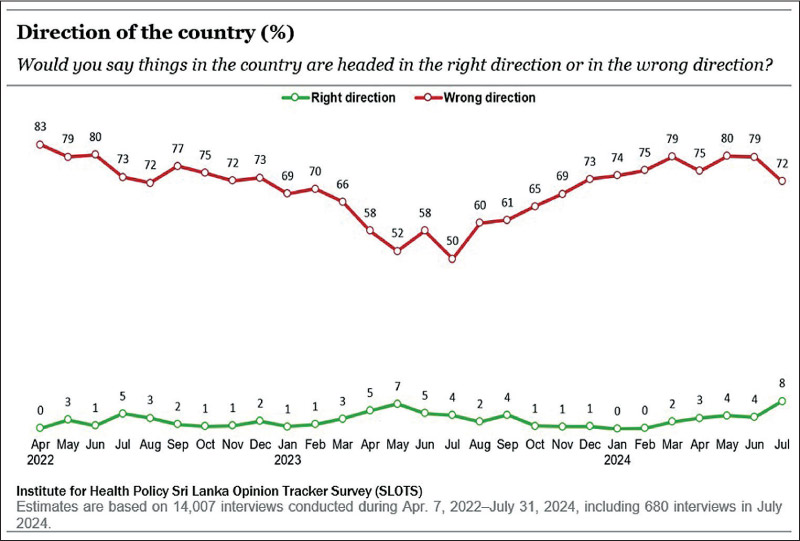Saturday Dec 13, 2025
Saturday Dec 13, 2025
Thursday, 15 August 2024 03:44 - - {{hitsCtrl.values.hits}}
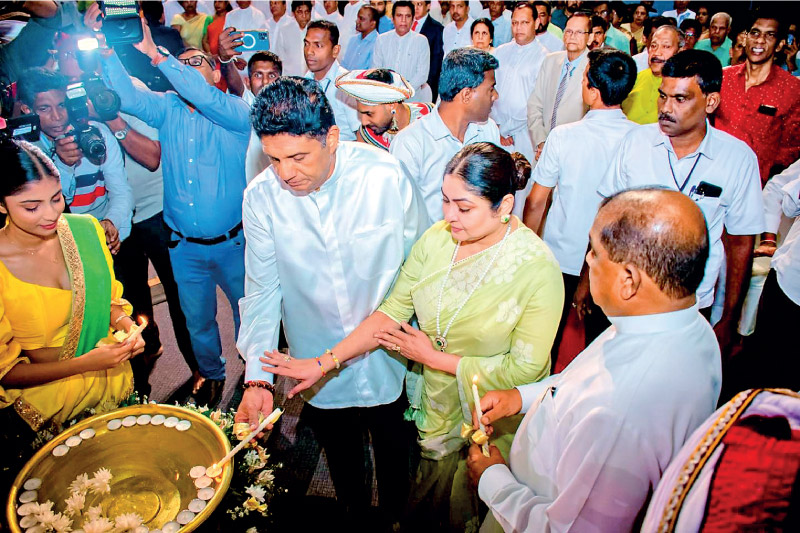
Long road: 25-year journey together
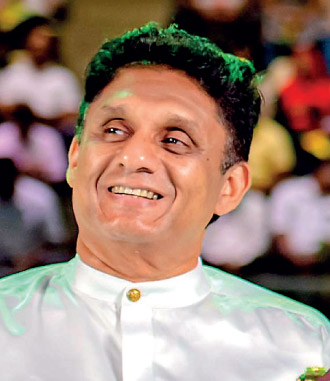
Social democratic candidate, Alliance leader
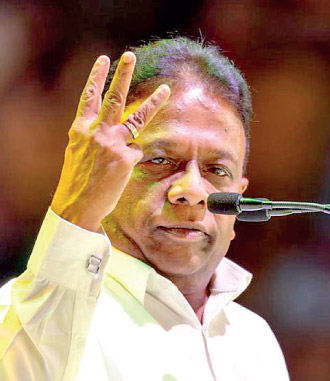
Dullas, centre-left endorsement
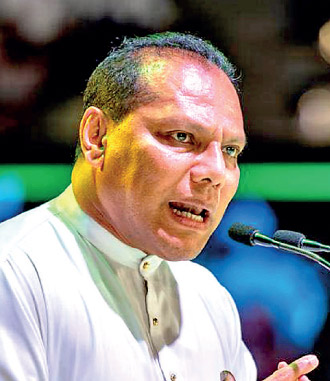
Dayasiri: Reformist SLFP endorsement
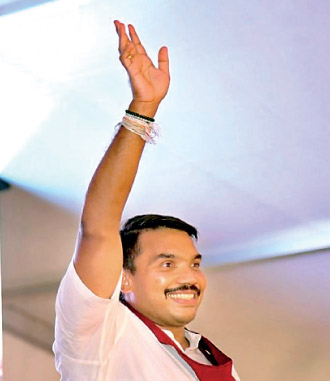
Could he decide the winner?
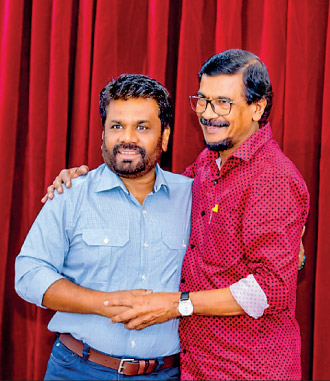
Anura, Tilvin, after signing nomination papers
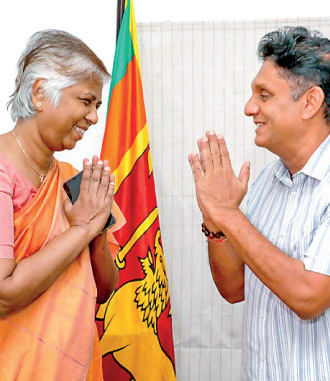
Respected Dr Sudharshini Fernandopulle joins SP
“Sri Lankans are more likely to think the country is headed in the wrong direction than people in any other country where this is polled. In June–July 2024, a global average of 62% of adults polled by IPSOS in 29 countries thought their country was headed in the wrong direction compared with 93% in Sri Lanka.”
(https://groundviews.org/2024/08/12/most-sri-lankans-think-country-is-moving-in-the-wrong-direction/)
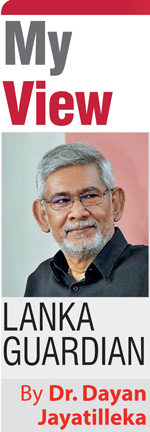 With only 8% of citizens thinking that the country is going in the right direction and 72% thinking it is “on the wrong track”, it would be borderline lunacy to assume that Ranil, ably supported by the most detested parliamentarians since 1970-77, could get into double-digits in September. “…Public views towards the country’s direction have worsened since July 2023, driven by a steady decline in uncommitted respondents.” (Ibid)
With only 8% of citizens thinking that the country is going in the right direction and 72% thinking it is “on the wrong track”, it would be borderline lunacy to assume that Ranil, ably supported by the most detested parliamentarians since 1970-77, could get into double-digits in September. “…Public views towards the country’s direction have worsened since July 2023, driven by a steady decline in uncommitted respondents.” (Ibid)
Sajith’s ‘soft power’
The pull-factor that took Apsari Sinhabahu Tillakaratne, ‘Wonder Woman’ behind our nationally inspirational women’s cricket team, and Sudarshini Fernandopulle, highly-respected doctor and politician, to Sajith Premadasa, is symbolic of a strategic reality: he has the ‘soft power’ to draw outstanding personalities outside his constituency to join or endorse him.
Meanwhile, Sajith’s new Alliance also shows that he has social and political partners, auxiliaries and ‘reserves’.
AKD-NPP, not so much.
‘…Dissanayake also revealed that many MPs who recently defected to the SJB had tried to join the NPP but were turned away due to their questionable histories. “Doesn’t this country need politics like that?” he asked’. (https://www.ft.lk/news/AKD-pledges-to-introduce-legislation-to-stop-political-crossovers/56-765355)
Apparently, those MPs were from the Dullas-GL faction(s). Where do their ‘questionable histories’ or political ‘pedigree’ (“patikiriya honda naha”) start and stop? What constitutes a ‘questionable history’ and what doesn’t? And ‘questionable’ in relation to whose or what history?
Who decides? A leader who laments the loss of friends and acquaintances to state terrorism in the 1980s as AKD did at a gathering in Thambuttegama where he schooled, but has yet to apologise for the ‘questionable history and pedigree’ of the party he leads, which includes slaughtering more Sri Lankan leftist leaders and activists than colonialism and the capitalist class ever did, and murdering minor public servants who distributed polling cards for elections?
August 8th Alliance
Sajith’s Samagi Jana Sandaanaya (SJS) was launched at the Sugathadasa Indoor Stadium on August 8th. The NPP and UNP dismissed the Alliance saying its components consisted of those who had been his partners earlier.
“Soon it will be announced that Sajith’s mother Hema also supports Sajith and has joined the Alliance” pronounced the NPP’s Dr Nalinda Jayatissa, acerbically and ungraciously. Chivalry was the personal hallmark from Marx and Engels to Fidel and Che. Lenin wanted Stalin sacked as Bolshevik party General-Secretary (only) because of rude speech. They’d have abhorred gratuitous, ungentlemanly reference to a political adversary’s mother. But then, civilité was never the JVP’s strong suit.
Moreover, the JVP-NPP misses the wood for the trees. On Aug 8th 2024 there were value-additions of qualitative importance: prominent Center-leftists Dullas Alahapperuma, Dayasiri Jayasekara and Prof Charitha Herath. They are reformist-dissidents from the SLPP and SLFP, representing the generic SLFP+Left ‘1956’ tradition.
When SLPP parliamentarians have shifted overwhelmingly to incumbent President Wickremesinghe, it is no small deal for Sajith to retain both his party (minus a few defectors) and his earlier allies. He’s done much better than Mahinda and Basil.
Sajith’s Alliance is, so far, a confluence of four main currents:
 The SJB, the main parliamentary Opposition party and a breakaway from the UNP.
The SJB, the main parliamentary Opposition party and a breakaway from the UNP.
 Key personalities of the SLFP/ex-SLPP Center-Left.
Key personalities of the SLFP/ex-SLPP Center-Left.
 The SLMC, the island’s main Muslim party.
The SLMC, the island’s main Muslim party.
 Tamil parties representing the hill-country and the Southern towns including Colombo city.
Tamil parties representing the hill-country and the Southern towns including Colombo city.
At the signing at the Water’s Edge of an MoU with Dayasiri Jayasekara, SLFP General-Secretary and leader of an SLFP faction, Sajith spotlighted the “theoretical” (“nyaayika”) compatibility between his own ideas and that of the SLFP, in as much as there is an overlap with the positive, progressive aspect of SWRD Bandaranaike’s ideas. This echoed President Premadasa’s last May Day speech (1992) in which he said he had transformed the UNP so totally that SWRD would never have thought of leaving it, and had the latter been alive he would have been on the UNP stage rather than on any other that year.
Dayasiri was Sajith’s wingman during the initial rebellion to reform and democratise the UNP in 2010-2011; a rebellion during which President Mahinda Rajapaksa saved Ranil, blocking access to the UNP headquarters Sirikotha for incoming party members from all over the island by initiating road construction overnight.
Progressive centre awakes
The broadened Alliance at the Sugathadasa Stadium strategically positioned Premadasa as the moderate progressive alternative in the Presidential race, with Ranil and the SLPP renegades occupying the neoliberal Right, and AKD-JVP-NPP, the populist Left.
Sajith occupies the ideological and programmatic centre; a New Middle Path, vital to sustainable reform and more fundamentally, to social, democratic and systemic stability.
SP always leaned towards the progressive centre and social democracy, going back to his November 2019 presidential campaign up to late 2022. There was a muting of social democracy during the Wickremesinghe incumbency and the counter-productive endorsement of his “economic doctrine and strategic direction” by the SJB’s Economic Council. That’s what gave AKD-NPP a multiplier, enabling near-exponential growth.
With the simultaneous ‘Battles of the Brands’ on two fronts, to draw the lines of demarcation between (a) himself and the SJB on the one hand, and Ranil Wickremesinghe on the other, as well as (b) between himself and the SJB on the one hand, and Anura Dissanayake and the JVP-NPP on the other, Sajith instinctively returned to the discursive triangle of progressive centrism, social democracy and (President Premadasa’s) developmental populism. AKD-NPP began dropping since.
The August 8th Alliance has anchored that progressive-centrist, social democratic orientation.
The alienated, fence-sitting Centre-Left vote could prove decisive. There is no basis other than progressive-centrism for an SJB plus dissident SLPP/SLFP bloc which can reach undecided ex-MR votes. Similarly, the combination of populist-reformists from the UNP tradition (Sajith and the SJB) and centre-left reformists from the SLPP-SLFP traditions (Dullas, Dayasiri, GL, Nalaka, Dilan et al.), cannot but amount to-- and produce-- a social democratic orientation.
This enables Sajith and the SJB to carve out a clear Third Space and Middle Path distinguishable from both Ranil Wickremesinghe and Anura Dissanayake.
Ranil stands for complete continuity; proceeding along the same path of growing poverty. That takes social sadism. It is the export-led, high-growth industrialisation model of Bangladesh that Nobel Prize winner Muhammed Yunus critiqued, tried to correct and counter-balance.
Anura Dissanayake and the JVP-NPP do not stand for ‘extreme socialism/leftism/communism’ as the SJB alleges, but do stand for unclear, untested change; open-ended radical reform; and economic amateurism. 40 days from the election, I still don’t know who the NPP’s chief economist is and what he/she thinks. I also have yet to read a definitive, standalone JVP-NPP economic text which presents its solution to the economic crisis with the debt crisis at its core.
Sajith stands for a combination of change and continuity; change within continuity and continuity within change. This provides the voters with a Third Alternative, that of moderate progressive, reformist change. Globally, it is this option of moderate change and a mixed economy that most people opt for as the intersection of ‘most desirable’ and ‘least risky’.
Had the SJB remained solo, clutching its old Blueprint with an economic doctrine indistinguishable from that of incumbent Wickremesinghe, it would have facilitated defections to its old boss. By contrast, what the Aug 8th Alliance and its discourse do is to inoculate it from that temptation by strengthening populist and social democratic ‘antibodies’.
Sajith Premadasa’s speech at the Sugathadasa Stadium as Presidential candidate and leader of the Alliance was not the razor-edged oratorical masterpiece (“a torch ablaze at both ends”) that his father’s was at the same venue on October 8th 1988 when accepting presidential nomination at the UNP’s Special Session. However, it had echoes of that speech (“voice of the voiceless millions”), progressive policy content, and cannot be defined as anything but ‘social democratic centrist’.
In his Aug 8th address, Sajith laid down a marker by praising President Roosevelt’s “new Social Contract” -- the New Deal-- as a response to the Great Depression. He went on to advocate public-private partnerships (rather than a fire-sale approach) to state enterprise. He committed to an improved, “strengthened” version of his late father’s Janasaviya anti-poverty program “which will be presented to the people very soon”.
Superiority of social democracy
Sajith explicitly reiterates his commitment to Social Democracy and goes onto unveil a creative concept: ‘Social Democratic Market Economy’. This bridges the gap between the global Centre-Left, Social Democratic view deriving from President Ranasinghe Premadasa who called for “economic, social and political democracy” and the global Centre-Right view pioneered by Konrad Adenauer’s German Christian Democrats, of a ‘Social Market Economy’.
Social Democracy is an ideology, a model of society, and an economic doctrine. Sajith positions himself ideologically/doctrinally/philosophically as a Social Democrat (“Samaaja Prajaathanthravaadee darshanaya”), committed to the social democratic goal of ‘growth with equity’.
He differentiates himself from a classic Social Democratic economy with its top-heavy statism and wall-to-wall welfarism, by accommodating/incorporating the ‘Social Market Economy’ while modifying it, reinforcing the social and mixed economy/Middle Path character of the model by re-locating it within Social Democratic parameters. Hence, ‘Social Democratic Market Economy’.
China defines itself and its worldview as ‘Socialist’, but describes its economic model as a ‘Socialist Market Economy’ or ‘market socialism’. Sajith Premadasa’s is a broadly Social Democratic paradigm, with a Social Democratic Market Economy. Those who think it an oxymoron should ponder China’s successful ‘Socialist Market Economy’.
In their significant speeches at the Sugathadasa Stadium, new Alliance leaders Dullas Alahapperuma and Dayasiri Jayasekara picked up the refrain. Dullas reiterated Sajith’s call for ‘Social Democracy’ and a ‘Social Democratic Market Economy’ while Dayasiri Jayasekara said “we must go beyond, to a Humanistic Social Democracy”.
This makes the August 8th Alliance a ‘first’. Not since SWRD Bandaranaike’s founding SLFP manifesto of 1951 called for ‘social democracy’ – but criminally let it be overlaid by cultural nationalism by 1955-’56--has any mainstream party openly endorsed Social Democracy.
Such positioning gives the SJB-led Alliance (SJS) an advantage over the JVP-NPP. Anura and the Maalimaawa haven’t yet officially declared themselves and their project in universally or globally recognisable paradigmatic terms.
It is not the combination of liberal democracy with neoliberal economics, nor liberal democracy with religio-cultural conservatism, that offers the best synthesis for humanity, but rather, liberal democracy with social democratic economics, that constitutes the most balanced, advanced, and humanistic form of modernity.
What is curious is that Anura Dissanayake could have laid to rest many misgivings that arise from the JVP’s past, by adopting Social Democracy before Sajith did. That would have been an obvious homebase for a leftwing party with a Marxist provenance. Yet he chose otherwise.
Given the collapse of the socialist option as alternative universalist vision and system, the crisis of free-market economic liberalism—neoliberalism—resulted in a Far-Right backlash from ultranationalist conservatism or rightwing populism usually with heavy ethnoreligious overtones.
This has brought home the need for a rectified liberal democracy; a strain of liberal democracy immunised against Far-Right populism. Social Democracy is political (liberal) democracy freighted with a different, fairer and more just social and economic content. It was also historically so, when it resisted Communism which it deemed totalitarian.
Social Democracy is the child of liberal democracy. Its great strength is that it is a fusion which combines two streams in history, stemming from two fundamental human –ontological--impulses, individual and collective. It fuses the resistance to and rebellion against absolutism, and for freedom and democracy, with rebellion against social and economic injustice, and for a fairer social order.
It is distinguishable from Communism which neglected/negated the struggle for freedom and democracy—individual and collective. Communism tended to over-emphasise, mono-causally and one-dimensionally, the struggle against economic exploitation and injustice and for socioeconomic justice.
When the liberal democratic Right (Reagan, Thatcher) and Communist Left clashed, what was eliminated was the centre-space, the middle-ground. That is the space of and for Social Democracy. Social Democracy is the political philosophy that best corresponds to the Buddha’s commendation of the Middle Path, the injunction of the Delphic Oracle ‘Nothing in Excess’, and Aristotle’s urging of the Golden Mean. Social Democracy is more complete and more advanced than its parent, liberal democracy. It stands the best chance of being the last universalist ideology standing.
Social Democracy is the main doctrine overarching and encompassing two moderate, modernist political models, almost archetypes:
a.Democratic Left
b.Progressive-Centrism/Centre-Left.
Significantly and symptomatically, Anura passed it up, Sajith picked it up.
The embrace of Social Democracy by Premadasa and his partners in the Samagi Jana Sandanaya (SJS) representing the most progressive-reformist elements of the main pillars of Sri Lankan democracy, the UNP and the SLFP-SLPP, makes August 8th 2024 a potentially historic date.
In the vortex of the current crisis, Sri Lankan voters must look for the political option that most closely approximates a social democratic ideology and program.
But what if Sajith and the SJB are merely ‘signaling Left to turn Right’? There will be guardrails. If the SJB’s rightwing pushes Sajith’s SJS administration off social democratic/Ranasinghe Premadasa policy rails, it will face:
(I)A powerful JVP-NPP Parliamentary and Provincial Council opposition.
(I I) A feisty SLPP led by Namal Rajapaksa.
(I I I ) The FSP-led Alliance of Aragalaya personalities driving the extra-parliamentary Opposition.
Namal’s guerrilla war
It took guts to do what Namal Rajapaksa did: contest the Presidential election in the worst possible circumstances. By contesting, NR is de-linking himself and the ‘survivalist’ younger generation of the party from the SLPP ‘barons’ who defected to Ranil. Thereby he ensures that he has at least a life-raft of a party for the future.
He also preserves for himself unmatched political capital, the value of which is way down now after Gotabaya’s lunatic economics, but will perhaps rise steeply someday: the sociopolitical capital of being the eldest son of the popular, war-winning President MR.
By riding against the wind, Namal is scripting a credible ‘heroic’ narrative: a young man taking a principled stand, on a lone ‘Mission Impossible’ to fight loyally for the national and economic policies of his famous father Mahinda, instead of surrendering and converting to Ranil’s anti-national neoliberalism at a time when most of the SLPP parliamentary group had betrayed the party’s banner.
“…Issues surfaced. An example is the divestiture of state property. The issue raised concerns with SLPP leader Mahinda Rajapaksa himself.” (https://www.sundaytimes.lk/240811/columns/after-dhammika-pulls-out-slpp-turns-to-namal-for-presidential-race-567347.html)
If Namal clocks 250,000 votes, he decides the winner, as Ossie Abeygoonasekara pretty much did in 1988.
Namal’s run is a rite of passage, which is a return to his roots. He is following in the footsteps of his grandfather DA Rajapaksa, sole parliamentarian to follow SWRD Bandaranaike out of the UNP government of the mighty DS Senanayake in 1951.
At its first election immediately after, in 1952, SWRD’s SLFP came third, behind the rightwing conservative UNP and the Marxist leftist LSSP. But the next election, 1956, was the ‘Silent Revolution’.
